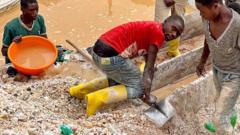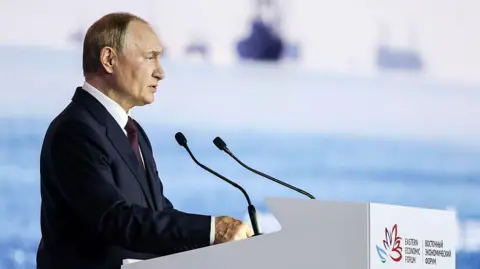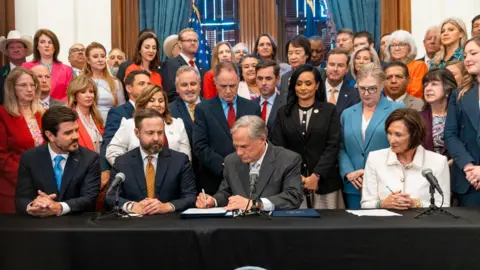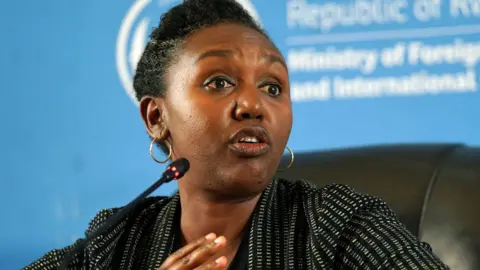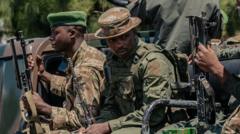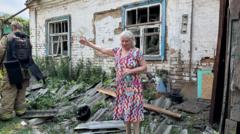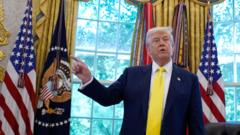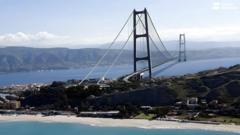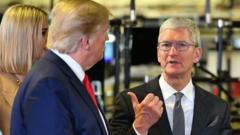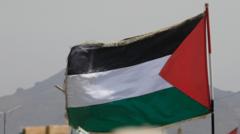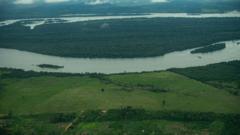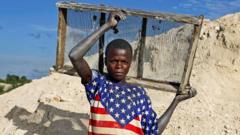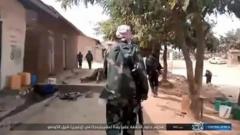More than 10,000 individuals labor daily at the Rubaya mine, vital to the mobile phone industry, as they dig for precious coltan ore under the watchful eye of M23 rebels in the eastern Democratic Republic of Congo. The BBC recently gained rare access to the expansive mining site, a testament to not only the hardships faced by workers but also the broader geopolitical struggles at play.
The Rubaya mine is characterized by an intricate network of pits and tunnels, where miners toil under intense conditions. Patrice Musafiri, the site supervisor since the rebel takeover in April last year, shared that "usually, we have more than 10,000 people working here daily." This grueling labor is riddled with hazards, as mineworker Peter Osiasi detailed, "When we are deep in the mines, temperatures are very high... plus there can be other harmful gases." Yet for many, including Osiasi who has now formed a family thanks to his earnings, the mine represents a lifeline amid chaos.
Situated in the lush Masisi Hills of North Kivu province and holding around 15% of the world's coltan supply, the Rubaya mine has drawn the attention of global investors interested in tapping into its mineral wealth. The region's fraught history, marked by ethnic tensions and armed conflict, has led to its ruination under various groups, including the Congolese army and M23 rebels, who have seized key territories including the city of Goma.
Recently, a ceasefire aimed at fostering peace between DR Congo and Rwanda was struck in Washington, but the underlying issues remain unresolved. Despite the M23's denial of any foreign backing, most experts view the group's control as a significant obstacle to stability. Amid these political intricacies, the potential for US investments in Congo's mining sector raises questions about the interplay of regional power struggles and economic interests.
Local miners express a desire for improved working conditions and fair wages, highlighting the connection between foreign investment and community development. Mr. Musafiri stated, “Any foreign investor can come here, as long as they come with development for our people.” Such changes are seen as critical, given the persistence of armed groups and the dire need for infrastructure to support the communities that mine these lucrative materials.
The findings from recent discussions suggest that American investment could also provide a stabilizing influence in the region. However, with the M23 still firmly in control, the path forward remains uncertain, leaving the local population and miners like Osiasi hoping for lasting peace and upward mobility. “My appeal,” he said, “is to keep and maintain peace in our area," further calling for an increase in miners' wages—their lifeblood in tumultuous times.
As geopolitical players negotiate their interests, the miners of Rubaya know that the true stakes lie in their daily labor and the hope of a better future in an area that has witnessed too much strife.
The Rubaya mine is characterized by an intricate network of pits and tunnels, where miners toil under intense conditions. Patrice Musafiri, the site supervisor since the rebel takeover in April last year, shared that "usually, we have more than 10,000 people working here daily." This grueling labor is riddled with hazards, as mineworker Peter Osiasi detailed, "When we are deep in the mines, temperatures are very high... plus there can be other harmful gases." Yet for many, including Osiasi who has now formed a family thanks to his earnings, the mine represents a lifeline amid chaos.
Situated in the lush Masisi Hills of North Kivu province and holding around 15% of the world's coltan supply, the Rubaya mine has drawn the attention of global investors interested in tapping into its mineral wealth. The region's fraught history, marked by ethnic tensions and armed conflict, has led to its ruination under various groups, including the Congolese army and M23 rebels, who have seized key territories including the city of Goma.
Recently, a ceasefire aimed at fostering peace between DR Congo and Rwanda was struck in Washington, but the underlying issues remain unresolved. Despite the M23's denial of any foreign backing, most experts view the group's control as a significant obstacle to stability. Amid these political intricacies, the potential for US investments in Congo's mining sector raises questions about the interplay of regional power struggles and economic interests.
Local miners express a desire for improved working conditions and fair wages, highlighting the connection between foreign investment and community development. Mr. Musafiri stated, “Any foreign investor can come here, as long as they come with development for our people.” Such changes are seen as critical, given the persistence of armed groups and the dire need for infrastructure to support the communities that mine these lucrative materials.
The findings from recent discussions suggest that American investment could also provide a stabilizing influence in the region. However, with the M23 still firmly in control, the path forward remains uncertain, leaving the local population and miners like Osiasi hoping for lasting peace and upward mobility. “My appeal,” he said, “is to keep and maintain peace in our area," further calling for an increase in miners' wages—their lifeblood in tumultuous times.
As geopolitical players negotiate their interests, the miners of Rubaya know that the true stakes lie in their daily labor and the hope of a better future in an area that has witnessed too much strife.

